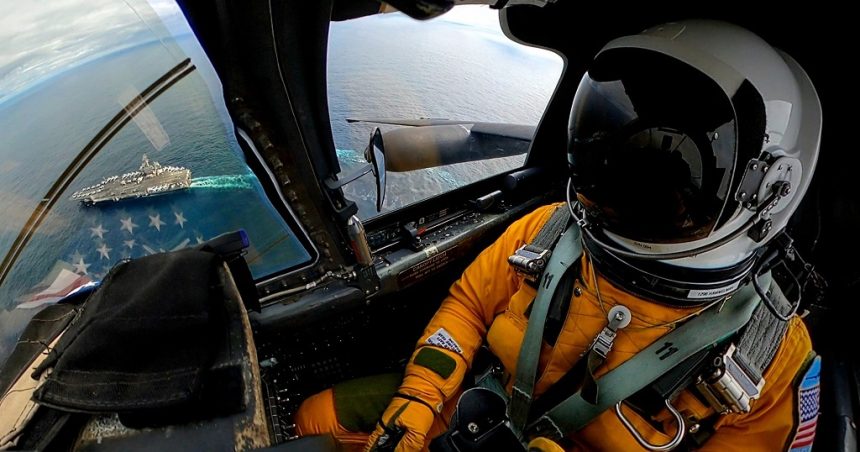The high-end realistic scenario of Northern Edge 21 allowed testers to assess the behaviour of new systems and upgrades before their fielding to frontline units.
Northern Edge 21, the premier bi-annual joint exercise of the U.S. Indo-Pacific Command, took place this year through May 3 to May 14 in locations in and around Alaska. The exercise, which involved Air Force, Army, Marines and Navy, recreated high-end realistic warfighter training to practice tactics, techniques and procedures and to improve command, control and communication relationships, improving the joint interoperability and enhancing the combat readiness in a large force employment training scenario with a focus on multi-domain operations.
With all these characteristics, Northern Edge provides an ideal joint test environment for new systems and capabilities to be evaluated in realistic combat scenarios as part of their initial, culminating and milestone tests. The Nellis AFB-based 53rd Wing deployed more than 25 aircraft from its tenant units, alongside the Eglin AFB-based 96th Test Wing and the 926th Wing, to Joint Base Elmendorf-Richardson, including the F-15C, F-15E, F-15EX, F-35, MQ-9, B-52 and U-2. The Wing achieved major test objectives for multiple weapons systems during the exercise, with a lot of useful data to analyze for further development.
“Northern Edge is an essential event for operational tests,” said Col. Ryan Messer, 53rd Wing commander. “It is one of only a handful of exercises that combine great power competition-level threat complexities with the joint interoperability necessary to realistically inform our test data. The individuals in the 53rd Wing continue to inspire me with how they challenge themselves and their programs in complex environments, ensuring we deliver the most lethal, ready and capable force for our nation.”
The common key objective for the assets deployed to Alaska was the integration of fourth- and fifth-generation aircraft, and in particular the integration of the newly arrived F-15EX Eagle with the F-35 Lightning II. Here below are some further details published by the 53rd Wing about the operational tests during Northern Edge 21, grouped by platform.
F-35A Lightning II
The 422nd Test and Evaluation Squadron recently fielded a new Operational Flight Program, called Suite 30P06, to the Combat Air Forces’ F-35s Lightning II. Northern Edge allowed operational testers to evaluate how the new OFP software functioned in a realistic threat environment to inform the tactics associated with the software. “At Northern Edge, we are validating our assumptions that we made in the OFP test process on a grand, realistic scale and incorporating WEPTAC Tactics Improvement Proposals,” said Maj. Scott Portue, 422 TES F-35 pilot.
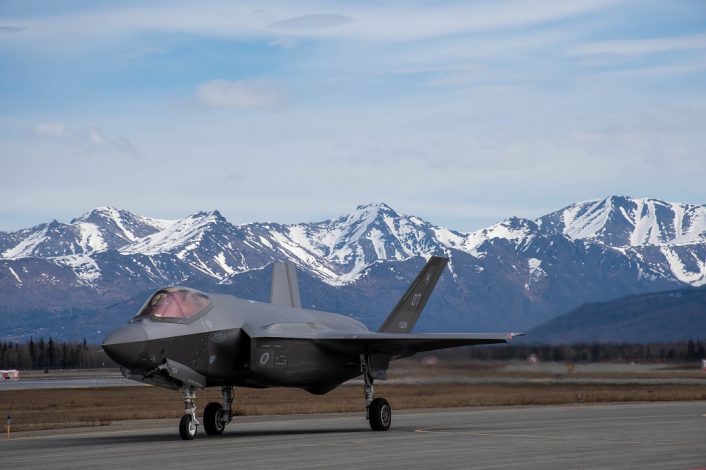
These Tactics Improvement Proposals, known as “TIPs,” are established at the annual weapons and tactics conference, which brings together warfighters to discuss current and future issues and to find solutions for joint operations (in fact, while this is primarily an Air Force event, Army, Marines and Navy often take part to the discussion). TIPs tested this year at Northern Edge by the 422 TES included F-35 emissions control, which consist in minimizing the F-35’s emissions to get as close as possible to the adversary, and fourth-to-fifth (and fifth-to-fourth) electronic attack tactics, techniques and procedures.
“As a fifth-gen. asset, we have stealth, so we can physically get closer, but we may not have all the weapons that a fourth-gen. aircraft, like a (F-15) Strike Eagle, does. We’re trying to figure out how we (fourth- and fifth-generation platforms) can benefit each other so that we can get closer to the adversary,” Maj. Portue said. The F-35’s integration with 4th gen. aircraft has been the focus of many exercises, and this example represent the importance of the integration.
Talking about these benefits, Maj. Portue further explained that, for example, the AN/ALQ-250 Eagle Passive Active Warning Survivability System (EPAWSS), which is being installed on the F-15, can allow an F-35 to control its emissions, while getting closer to the enemy, by not using its own radar or employing its own EA (Electronic Attack) capabilities. Additionally, the F-35 performed missions in the Gulf of Alaska focused on exploring maritime tactics and joint interoperability with the other branches of the military.
“When we talk about fourth- and fifth-gen. integration, we absolutely mean joint integration. Northern Edge is the biggest melting pot that we have as a joint force, in which we can test the most cutting-edge technologies, OFPs (operational flight program) and tactics and see how they match up against a near-peer threat,” Maj. Portue said.
F-15C Eagle, F-15E Strike Eagle, F-15EX Eagle II
One of the main goals for the F-15 testers during Northern Edge 21 was the testing of EPAWSS by exploiting the complex electronic attack environment created for the exercise. According to the Air Force press release, EPAWSS was put to the test in the F-15E Strike Eagle, which is set to receive the new system as an upgrade, and the F-15EX Eagle II, which will be equipped with EPAWSS from the factory.
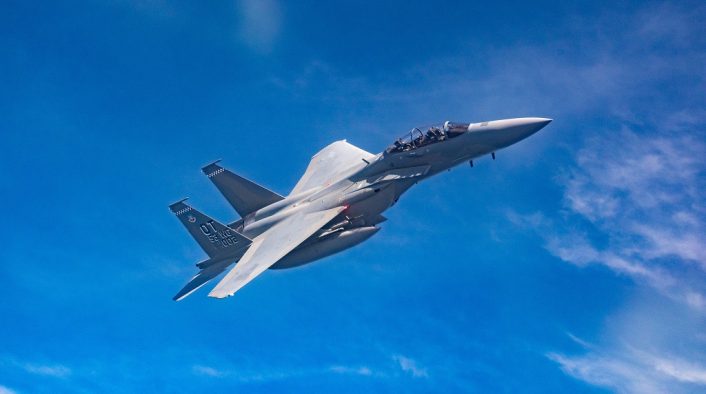
However, we can notice from the photos released that EPAWSS appears to be installed also on two F-15Cs deployed to Alaska for the exercise. Initially, the Eagle was set to receive the new system along with the Strike Eagle, however it was later decided to abandon the project because of the not-so-distant retirement of the aircraft.
One of the milestones reached during Northern Edge is the first-ever four-ship mission of F-15Es equipped with EPAWSS, which flew on May 14 and saw the Strike Eagles employing EPAWSS as it would be used operationally in a tactical formation. Lt. Col. Reade Loper, Operational Flight Program Combined Test Force F-15E test director, remarked the significance of this milestone as the large force, dense-threat environment of the exercise provided opportunities for growth that might be difficult to recreate during home-station flying.
One of these opportunities came from the continuous evolution of modern EW combat scenarios, with threats changing their emissions to avoid jamming and countermeasures. This kind of scenarios require a continuous work on the database that lies within systems like EPAWSS to adapt them to new threats, and the speed of this process is vital. A demonstration of this was performed by the system’s producer, BAE Systems, which was able to rapidly reprogram and improve the mission data files for EPAWSS during the exercise over just one to two days.
Another system that was tested on the F-15, and specifically the F-15C, is the Legion Pod IRST (Infrared Search and Track) system. Northern Edge 21 was the last step to complete the operational flight testing of the Legion Pod, a “graduation” test event as described by the Air Force, before the fielding of the new system with the frontline squadrons.
The Legion Pod integrates the IRST21 sensor, the same that was selected for the F/A-18E/F Super Hornet to be integrated on the centerline external fuel tank. Unlike the radar, the IRST is a passive sensor which does not have electronic emissions and can work also in presence of jamming systems. Last year, an F-15C used the pod during a test mission to target and launch an AIM-9X IR-guided air-to-air missile without the use of the radar.
Maj. Aaron Osborne, 28th Test and Evaluation Squadron F-15C pilot, explained that the IRST allows pilots to have an “out-of-band” sensor to find what an electronically scanned radar (AESA) cannot, particularly in the event of an electronic attack. “IRST pod is an added capability to the warfighter and is proving capable in the dense electronic attack threat environment of Northern Edge,” Maj. Osborne said. “While at Northern Edge, I’m using the pod not as a test pilot, but exactly as I would in the CAF or in operations. We’re checking the final boxes of the test plan here before the pod fields and using it with the latest operational flight program.”
Northern Edge 21 was also the perfect opportunity to test the latest operational flight program for the F-15C and F-15E, called Suite 9.1RR (Re-Release), which is similar to the OFP used by the F-15EX, Suite 9.1X. The new software, which will be soon fielded to the CAF, brings new capabilities that otherwise would have had to wait until Suite 9.2 in late spring of 2023. Among the improvements, one of the most notable is the new Data Transfer Module 2 (DTM II). The DTM is the system used to transfer all the data needed for a flight mission (route, IFF codes, radio frequencies, weapon settings and so on) from mission planning computers to the aircraft.
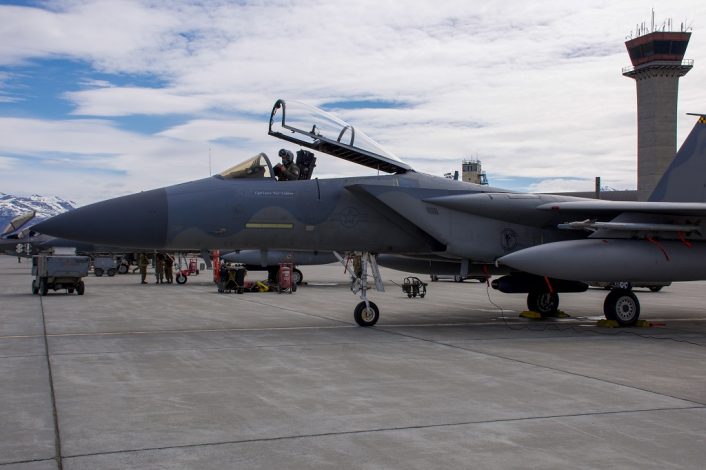
Until now, the F-15 kept using the same system that was fist developed in the 1980s, but the latest aircraft processor, the Advanced Display Core Processor 2, and new OFPs needed more memory than it was available on the DTM. “With 9.1RR, we’ve been able to upgrade the entire data transfer system to keep up with our new software. DTM II increases in memory capacity from 2MB to 256GB,” Lt. Col. Loper said. “With the increase in memory and processing power, we can now add all sorts of new tactical capabilities to the aircraft.”
Northern Edge 21 saw also the participation of the two recently delivered F-15EXs.
During the exercise, the Air Force assessed during 33 flight sorties how the F-15EX performs in the roles usually assigned to the F-15C and how to bring new capabilities to the mission. Air Force Magazine talked to Lt. Col. John O’Rear of the 84th Test and Evaluation Squadron, who provided some more details.
The Eagle II was paired with the older F-15C and F-15E, as well as the fifth-generation F-22 and F-35, both shooting down adversaries and getting shot down itself. “If you go into any large force exercise and you come back with everybody—with no blue losses—I would probably say that your threat is not as robust as it needs to be, in order to get the learning,” Lt. Col. O’Rear said. “In this kind of environment, most of your blue ‘deaths’ are probably going to be outside of visual range, just because of the threat we’re replicating.” The scenario was purposedly designed to be unforgiving so the blue forces would sustain losses that are used to discover weaknesses and find out how to mitigate or eliminate them.
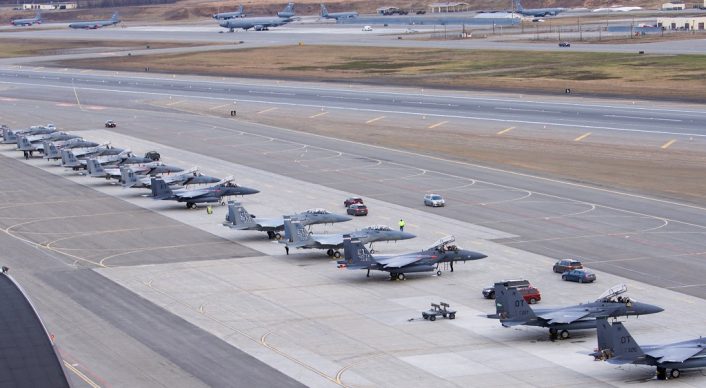
MQ-9 Reaper
Another asset that was heavily involved in testing activities at Northern Edge is the MQ-9 Reaper, with the 556th Test and Evaluation Squadron operating out of Eielson Air Force Base while working with new pods, including the hardened targeting pod and Reaper Defense Electronic Support System, and auto-take-off and landing. The Reaper is in fact receiving new capabilities that will bring it to the new MQ-9 M2DO (Multi-Domain Operation) configuration, ensuring that it will be able to support operations over the next 10 to 15 years.
“The hardened targeting pod has an electro-optical counter-counter measure and testing that is one of our objectives at Northern Edge,” said Lt. Col. Mike Chmielewski, 556th TES commander. “We’re also demonstrating the capability of the RDESS pod, of which there is currently only one in the world.”
The RDESS pod is a broad spectrum, passive Electronic Support Measure (ESM) payload designed to collect and geo-locate signals of interest from standoff ranges, providing the MQ-9 the ability to find and detect threats from a safe distance in contested environment the one replicated during Northern Edge. Another upgrade tested is the anti-jam, anti-spoofing (AJAS) system TIP, which utilized new aircraft antenna capability to see its impacts on GPS effectiveness in a denied environment and mitigate potential jamming to the platform.
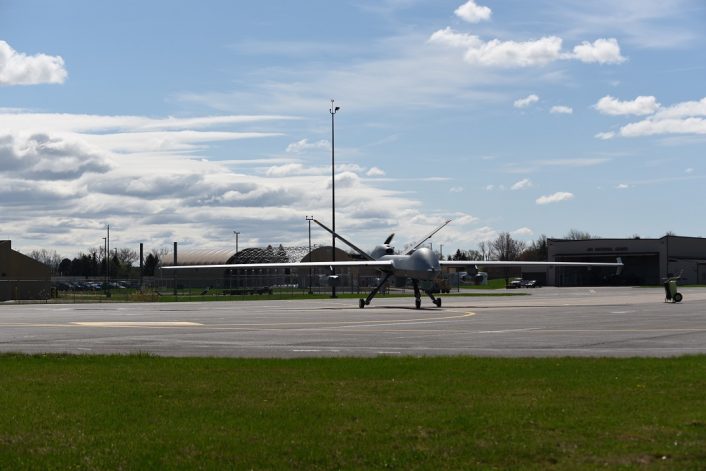
The 556th TES was not the only unit doing testing with the MQ-9 during the exercise.
The 174th Attack Wing, based at Hancock Field Air National Guard Base in Syracuse (N.Y.) tested three new pods while deployed at Eielson AFB, part of an Air National Guard program known as the Ghost Reaper which aims to integrate the MQ-9 in the Joint All-Domain Command and Control system in a contested battlefield.
The pods are the Northrop Grumman’s Freedom Pod, which houses a communications gateway system that connects fourth and fifth generation fighters via Intra-Flight Data Link (IFDL), Multifunction Advanced Data Link (MADL), Link 16, and Tactical Targeting Network Technology, the Ultra Electronics’ Rosetta Echo Advanced Payloads (REAP) pod, which improves targeting with improved connections to ground systems, and the General Atomics’ own Centerline Avionics Bay, which employs artificial intelligence and hardware expanding capabilities not originally built into the MQ-9 airframe.
B-52H Stratofortress
A B-52 from the 49th Test and Evaluation Squadron flew a more than 13-hour sortie from Barksdale Air Force Base (Louisiana) to Alaska and back, conducting a successful simulated hypersonic kill chain employment from sensor to shooter and back on May 5. Obviously, the B-52 did not launch any hypersonic ordnance during Northern Edge 21, as the long-waited AGM-183A ARRW (Air-launched Rapid Response Weapon) first flight test has yet to happen (a first attempt in April failed preventing the release of the weapon).
During the test mission, the Stratofortress was able to receive target data from sensors via the All-Domain Operations Capability Experiment (a joint team that allows the synchronization of joint functions in forward, contested environment when traditional C2 structure effectiveness is degraded or denied), located more than 1,000 nautical miles away miles away at Joint Base Elmendorf-Richardson, and then successfully take a simulated ARRW shot at the target from 600 nautical miles away.
“We were really exercising the data links that we needed in order to complete that kill chain loop, and then get the feedback to the players in the airspace that the simulated hypersonic missile was fired and effective,” said Lt. Col. Joe Little, 53rd Test Management Group deputy commander.
U-2 Dragon Lady
The 9th Reconnaissance Wing deployed a U-2 Dragon Lady from Beale AFB which acted as a critical hub of ISR during the exercise. Details about the U-2 participation are scarce, but a press release of the 53rd Wing before the beginning of Northern Edge 21 mentioned that the 53rd Test Management Group, Det 5, at Beale AFB was to deploy the U-2 for communication gateway testing.
This testing might be related to Project Hydra, which recently allowed the F-22 and F-35 to establish bi-directional communications each using its own datalink, the IFDL and MADL respectively, via a “translator” payload installed on the U-2S. As we explained in past article, the F-22 and F-35 can’t talk freely between each other as the “language” used by their datalinks is different and needs to be translated in order for the receiving aircraft to interpret the data.
During the drills, a U-2 also flew at low altitude over an aircraft carrier (USS Roosevelt): something that we have rarely seen in the recent past.
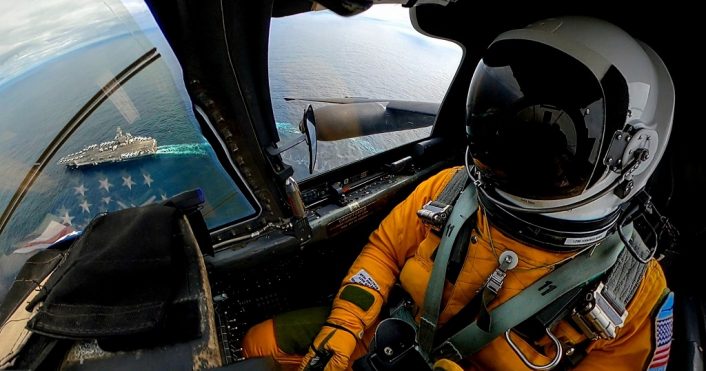
Other participants
In spirit with the joint employment of the forces, Northern Edge 21 saw also the participation of the Navy, Marines and Army. The Navy deployed the USS Theodore Roosevelt (CVN-71) aircraft carrier, which conducted more than 300 aircraft launches and traps, and its embarked squadrons completed more than 830 flight hours during the exercise.
A P-8 Poseidon of the Patrol Squadron One (VP-1) “Screaming Eagles”, stationed at Naval Air Station Whidbey Island (Washington), was also deployed to Joint Base Elmendorf-Richardson to provide the joint force participating in Northern Edge 2021 with a multi-mission maritime patrol, available for Anti-Submarine Warfare (ASW), Anti-Surface Warfare (ASuW), Intelligence, Surveillance and Reconnaissance (ISR) and collateral Search And Rescue (SAR) missions, both over water and land.
The Marines deployed the Makin Island Amphibious Ready Group (ARG) and the 15th Marine Expeditionary Unit (MEU), which executed various air and amphibious operations from the amphibious assault ship USS Makin Island (LHD-8) and amphibious transport docks USS San Diego (LPD-22) and USS Somerset (LPD-25) while maneuvering over the Joint Pacific Alaska Range Complex. The Marine Wing Support Detachment of the Marine Medium Tiltrotor Squadron (VMM) 164 (Reinforced) also established a Forward Arming and Refueling Point (FARP) at Cold Bay to provide around 85,000 lbs of fuel to multiple aircrafts from all branches of the military.
The Army conducted an airborne operation on May 11, with approximately 300 paratroopers from the 1st Battalion, 501st Parachute Infantry Regiment (assigned to the 4th Infantry Brigade Combat Team (Airborne), 25th Infantry Division) dropped by multiple C-17 Globemaster III and C-130 Hercules aircraft while A-10C Thunderbolt IIs provided close air support. The paratroopers seized Allen Army Airfield at Fort Greely (Alaska), allowing an M142 High Mobility Artillery Rocket System (HIMARS) battery from the 17th Field Artillery Brigade out of Joint Base Lewis-McChord, forward deployed to Cold Bay, to be airlifted there and conduct a live fire exercise at the nearby Donnelly Training Area, demonstrating the ability of the joint force to quickly build and implement combat power.

